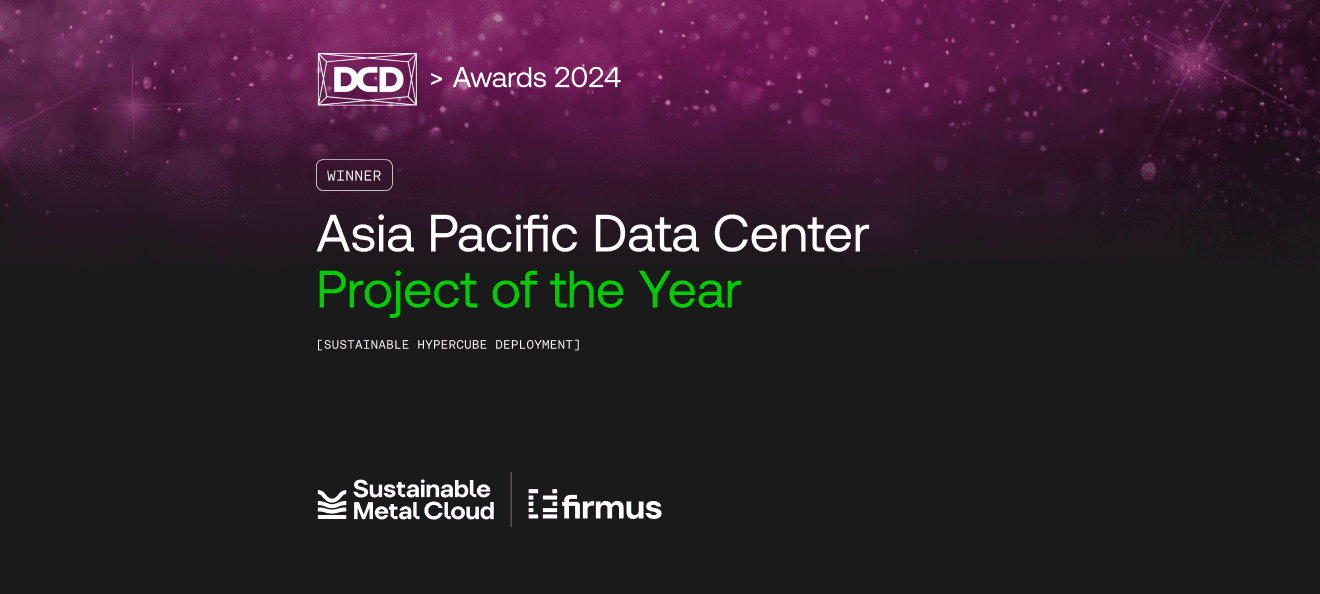April, 2024 | Updates
SMC Chairman Ted Pretty: Leading the Charge for Sustainable AI Computing
We sat down with Ted to discuss the evolution of the DC industry.

1. Seven years ago, a team of Australian entrepreneurs founded Firmus with a vision to develop a highly sustainable AI GPU supercomputer. Could you share the driving factors behind the original vision that led to SMC?
The original vision was to redesign the way that compute power could be efficiently cooled at scale. This vision came from the team in the early days of cryptocurrency mining, where the immense energy requirements highlighted the need for a more efficient cooling solution.
The vision has evolved alongside our technology; advanced cooling technology, globally scalable, delivered via an AI infrastructure stack. We’re now advocating for the rapid adoption of liquid immersion solutions and regenerative design. To make sure that AI development begins on a foundation of sustainability, and ensure that data centers contribute positively to the circular economy and energy markets.
2. What drives your passion for AI infrastructure and supercomputer solutions?
At the heart of our dedication to AI infrastructure and supercomputer solutions lies a profound commitment to sustainability. This passion for sustainable progress is what drives us forward, guiding our efforts to make a tangible, positive impact on the world through our work.
“It’s not just about advancing technology but doing so in a way that showcases sustainability in action, proving that groundbreaking innovations and environmental stewardship can go hand in hand.”
3. The partnership with STT Global Data Centres (STT GDC) in 2023 was a significant step for Firmus & SMC. Can you describe how this collaboration came to be and what it means for the future and the broader data centre industry?
Our collaboration with STT GDC marked a pivotal moment for us, driven by shared commitments to sustainability and a vision to lead globally in sustainable AI compute. Location has been key here. We wanted to launch within a region who share this vision; Singapore’s 2030 Green Plan and National AI Strategy shows the path forward. By delivering the SMC platform from within STT GDC’s infrastructure, we’re operationalizing our vision in Singapore and setting a global benchmark in energy savings and carbon emission reductions.
For the future, our platforms are now being scaled into STT GDC data centres across the globe. At our launch AZ in Singapore, on average we’re experiencing a 48% reduction in energy consumption for H100 HGX-based workloads, versus a benchmark for running the exact same system on legacy infrastructure.
“Our joint commitment enables large AI training and inferencing clusters to be delivered in the market with exceptional advancements towards sustainability goals.”
4. You’ve mentioned that data centres today are becoming the AI factories of the future, a vision also echoed by NVIDIA’s CEO, Jensen Huang. How do you see SMC playing a pivotal role in this transformation?
As Jensen said in 2022, data centres will need to process mountains of continuous data to train and refine AI models and by manufacturing intelligence. SMC recognised that this has massive implications for AI-friendly data centre design and energy usage. By deploying our liquid immersion cooling platform to host NVIDIA’s latest AI GPUs, SMC is not only enhancing the efficiency of high-density compute operations but also significantly reducing their energy consumption and carbon footprint.
Put simply, our technology can be a key component for the AI factories of the future.
5. AI is going through a period of exponential growth. How do you see the DC space aligning with the evolving demands?
AI GPU demands, and indeed even traditional CPU demands, for hosting are still growing exponentially. There is considerable pressure for more growth in data centre facilities. But the world is changing, and sustainability and efficiency is now driving where and how these facilities are built. Governments are concerned about power usage and impact on their energy grids, as well as the space required for the facilities.
The focus is on solutions that can reduce power loads for cooling and also increase densities. Through these efforts, we are future-proofing data centres against the backdrop of evolving AI requirements.
“We’re going to lead this transformation by prioritising sustainability and efficiency in the design and construction of data centres, replete with AI computing power.”
6. With cloud service providers seeking greater access to GPU capacity, what challenges do they face?
This issue is quite complex. First, there are geopolitical concerns of who can get access to the latest GPU chips. Secondly, there are geographic restrictions on where they might be hosted. Thirdly, there are the issues of appropriate data centre capacity and capability. Finally, there are the major considerations of power costs that flow through to the CSPs.
Point three is arguably the most important. Today there is a general lack of power in high quality IDCs and appropriate infrastructure. Only 5% of global IDCs can accommodate rack densities greater than 50kw. If I contextualise that with where the AI industry is going, it’s rumoured NVIDIA’s, next-generation Blackwell architecture (B100) for deep learning has been designed around a 1,000w TDP. Higher TDPs are not going away.
7. Firmus and SMC recently achieved a significant milestone by expanding it’s NVIDIA H100 HGX-based AI cluster in Singapore – running entirely within the immersion-based HyperCube. Can you discuss the impact of this achievement on the industry and the benefits it brings?
Deploying NVIDIA H100 HGX servers in immersion cooling is not a trivial achievement. GPU compute is complex and requires an incredibly detailed knowledge of how the servers operate in liquid, how heat will be dispersed and how networking interfaces will operate. Doubly challenging is the SXM board itself – running full 900gbps NVSwitch. The SXM board is often described as the world’s most complicated computer, and for good reason. Running this at hyperscale, within an immersion environment, is a world first.
For CSPs seeking GPU capacity, we can facilitate scale in a managed environment, reducing upfront capital spend and lowering operating costs. For AI platforms or enterprises, we offer the tools and foundation to build sustainable AI, as a certified NVIDIA CSP partner.
“SMC’s achievement is significant; we have demonstrated that we can optimise the performance of the most powerful GPUs in immersion, and deliver it with enterprise-grade uptime and reliability. It is a game changer.”
8. Looking forward, what are your aspirations for SMC? Are there any upcoming projects or areas of innovation that particularly excite you?
To keep pushing the DC industry forward, and drive the adoption of sustainable AI. In the short term, we are continue to expand our AZs in Singapore and will expand across Asia and into India in the first half of this year; alongside planning for GDPR-compliant AZs in Europe.
Our aspirations are to be a global provider of sustainable AI compute. Everything hinges on constant innovation. We are, as always, investing in research and development looking at technology improvements to optimise performance, lowering costs and energy consumption.








